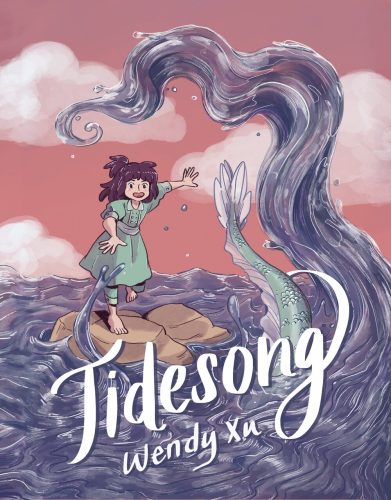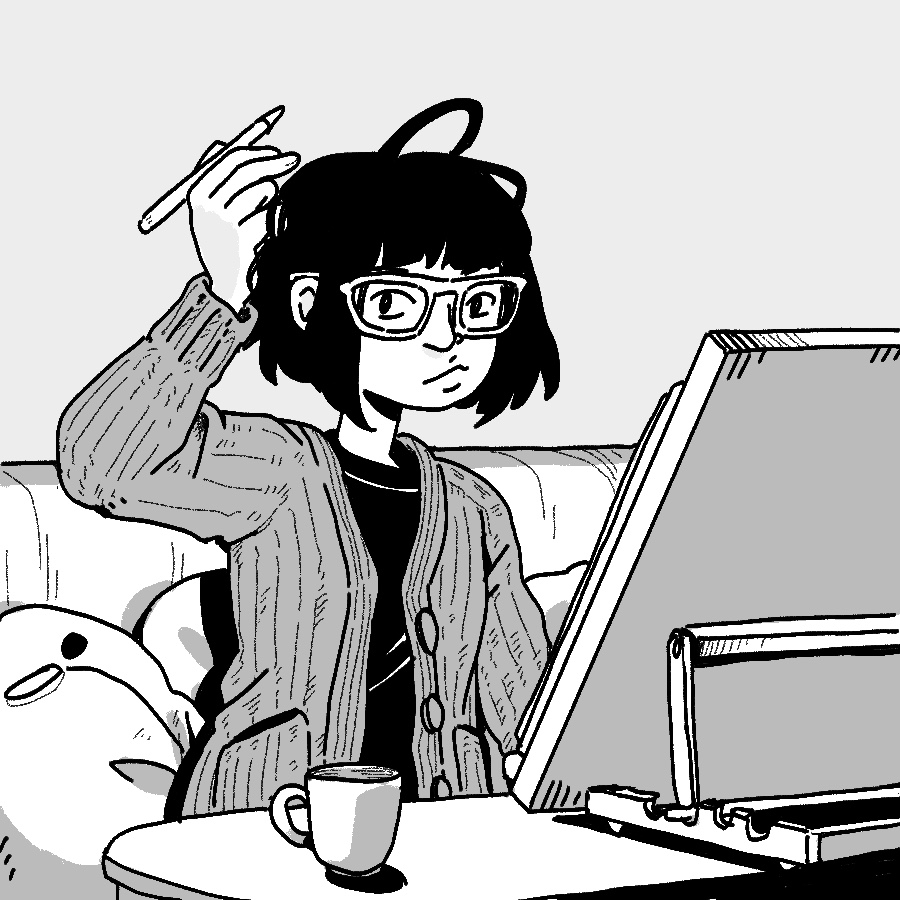Welcome to May We Present…, a column from Lambda Literary that highlights creators with recent or forthcoming publications. Our final feature of the year is Wendy Xu and their new graphic novel, TIDESONG, which was released on November 16th by Quill Tree Books. TIDESONG follows a young witch, Sophie, who leaves home to train for the entrance exam to a rigorous magic school. While living with her great aunt and cousin, she accidentally becomes entangled with a young water dragon named Lir, and the two must work together to undo the magic that binds them whilst navigating Sophie’s frustrations with her relatives and training.
TIDESONG is Xu’s solo graphic novel debut but her experience with the craft and dedication to the form are evident. The book is engaging from start to finish, saturated with colorful, vivid images that animate the story in an incredibly effective and affecting way. Xu has mastered the art of bringing words and visuals together, and she does so in a way that features the communicative abilities of art without simply relying on text to pick up the slack. As she states below, “There is no real distinction between words and images,” and TIDESONG, with its simultaneous yet seamless engagement between the two mediums, proves that Xu practices what she preaches. This book, paired with Xu’s insights below, will leave you with a greater appreciation of the graphic novel form and may fundamentally change the way you think about the relationship between images and text in your everyday life.
Below, Wendy Xu discusses fantasy as metaphor, offers advice to those interested in trying their hand at graphic novels, and reveals how they organize their books at home.

When did you realize you had to create TIDESONG?
It kind of came about in a very practical way—a bunch of publishing professionals said my creative voice was very well suited for the eight to twelve-year-old crowd, maybe I should try a comic for that age group. So I started thinking about what I enjoyed reading and watching at that age, and kept coming back to Kiki’s Delivery Service, The Worst Witch, Halloweentown… I knew I had to make a story about a witch-in-training at the very beginning of her career, so to speak, and the pressures of being twelve on top of having magical powers.
TIDESONG is your solo graphic novel debut. What was different about the experience of producing a solo graphic novel, as opposed to doing so collaboratively?
There are pros and cons to both. The major difference was that I had to write the whole story instead of working off of a script. While I definitely made script edits to MOONCAKES while drawing (combining panels, condensing a bit of dialogue here and there to fit the art, etc), with TIDESONG it was a bit more of an organic process since I could think about visuals first and then how the dialogue would fit around the art. I always start with the art, it just makes sense for a comic.
Many of your works, including TIDESONG, are rooted in magic and fantasy. What continues to attract you to these genres and worlds?
I love that fantasy is an ultimate expression of metaphor for the world around us and for our lived experiences, even if those experiences don’t map exactly 1:1. That’s the point, I think—that we can make the invisible visible while providing a bit of a buffer and an escape for the reader from our world. One of my favorite examples of an almost perfect metaphor is the daemons in Pullman’s His Dark Materials stories. They stand for so many things—a shadow self, your soul, your inner voice, your instinct, your relationship to the divine, but externalized as a physical being… there are so many different ways to read it and think about it. There are also invisible things within our own world that can only really be experienced through the lens of metaphor, such as the hidden world of fungi and microbes. I took to reading about nature during the pandemic, and what struck me was the similarity between nature writers and fantasy writers. Whether a fun story or a scientific concept, metaphor is so important, and exploring it through fantasy helps to bring empathy and thoughtfulness.
TIDESONG engages with topics of mental health, intrusive thoughts, and the importance of communication, and the formal qualities of the work aid in the exploration of these themes. What did the form of the graphic novel enable you to do with TIDESONG that other mediums might not have?
This might seem obvious, but the comic medium is a really great way to use color, shape, and line to express thoughts and feelings in a very visceral mode. Our brains process images and written words differently. When drawing a comic, I feel like I’m tapping into a much more raw emotional place because I’m such a visual person. I ask myself, “What does it feel like to have an intrusive thought?” And the result (in my experience) is that the thought cuts through everything else you’re doing at that moment, so I draw it as a jagged shape across the panels, and the color is used as a jarring contrast to all the other colors on the page. But the other thing I love about a comic is its ability to have the characters engage directly with the speech balloon, the shape of the thought. I like comics where the character reaches up and touches the balloon and plays with it—it’s a visual metaphor for how we engage with our own words and thoughts. We read that page and understand innately what the author is trying to tell us, instead of having to engage with the text by asking ourselves what each word and sentence means to the story.
What do you find most difficult about the process of producing words and images together? What advice do you have for people interested in trying their hand at graphic novels?
Words and images are meant to go together! I teach creative writing to middle and high schoolers, and I teach out of the excellent Lynda Barry’s Making Comics. To paraphrase Lynda, when you’re a very young child, there is no real distinction between words and images—it’s only when we get older that these artificial boundaries are created for us by teachers, parents, and other adults, many of whom think comics are not “real books.” The most difficult part for me is how to condense and edit down a piece of dialogue in a way that will highlight the art, which is where the real story lies. I often find myself deleting dialogue because the art says it all. My advice is to draw and write at the same time—the drawing can be super crude, stick figures, but you’ll be getting a sense of story pacing and how much dialogue will fit in a panel, and those things are much more important in comics than having perfect, beautiful art. Everyone I know who is amazing at comics at least tries to draw them, even if their main job is writing them. The visuals are central to the process, so get comfortable with making art, even if it’s bad art.
Evidently, you work across multiple creative mediums. What do you find yourself doing when you need a complete and utter break from creative work?
I play cute life-sim video games. These days, it’s mostly Cozy Grove and Animal Crossing.
How do you organize the books you own? Take us on a verbal, visual tour.
The books I reference the most go on the shelf in my living room. The top shelves are for my personal favorites, mixed with books by my good friends and colleagues (the two categories often overlap), the bottom two shelves are manga and art books. I have a bin of zines and minicomics I’ve picked up from conventions that I refer to a lot because the art is so wonderful.
What are some LGBTQ+ themed graphic novels or graphic novels by queer creators you’d recommend?
ON A SUNBEAM by Tillie Walden; O Human Star by Blue Delliquanti; Artie and the Wolf Moon by Olivia Stephens; Estranged by Ethan Aldridge; Don’t Go Without Me by Rosemary Valero O’Connell; the upcoming Mothkeeper by K. O’Neill; and the entire Peow Studios catalog of which there are MANY queer creators.
Lastly, what’s the one line or image from TIDESONG that you just can’t get out of your head?
Auntie’s disapproving face!



